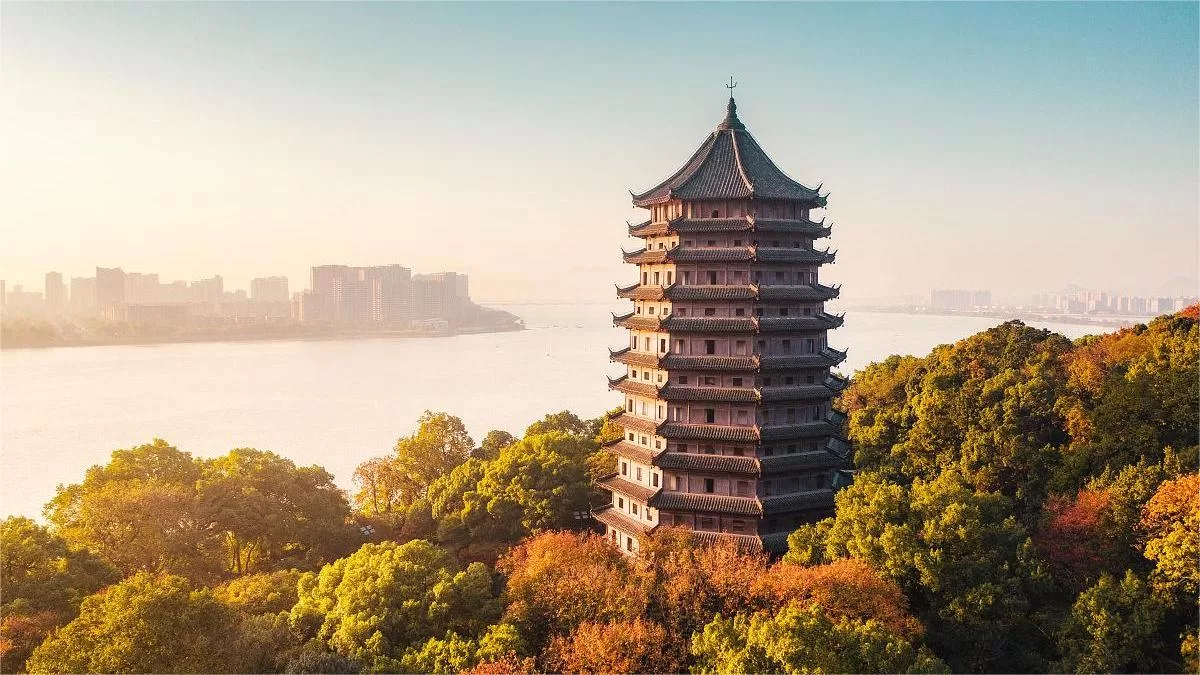Liuhe Pagoda (六和塔), named after the Buddhist concept of “Six Harmonies and Respect,” has a rich history dating back to the third year of the Song Dynasty’s Kaibao era in 970 AD. The original site of the pagoda was in the Southern Orchard of Qian Hongchu, the King of Wuyue. Initially constructed to suppress the tidal waves of the Qiantang River, Liuhe Pagoda has long been a favored spot for poets and scholars to contemplate the river and compose verses. During his visit in the Qing Dynasty, Emperor Qianlong inscribed plaques on each level of the pagoda.
Table of Contents
- Basic Information
- Location and Transportation
- Highlights of Liuhe Pagoda
- Vlog about Liuhe Pagoda
- Attractions near Liuhe Pagoda
Basic Information
| Estimated Length of Tour | 0.5 – 1 hour |
| Ticket Price | Admission: 20 RMB Ascending the Pagoda: 10 RMB |
| Opening Hours | 7.00 – 17.30 (1st May – 31st October) 7.00 – 16.55 (1st November – 30th April) |
| Telephone Number | 0086-0571-87977767 |
Location and Transportation
Liuhe Pagoda is located at 16 Zhijiang Road, Xihu District, Hangzhou, Zhejiang Province, China. It stands beside the Qiantang River, providing a scenic location for visitors to enjoy both the historical pagoda and the natural beauty of the Qiantang River.
To get there, you can take bus 439, 500, or 7280 and get off at Zhijiang Road Liuhe Pagoda Stop (之江路六和塔站).
Highlights of Liuhe Pagoda
Structure of Liuhe Pagoda

Occupying an area of 890 square meters, Liuhe Pagoda stands at a height of 59.89 meters. The internal core of the pagoda is a seven-story brick and stone structure, while the external wooden structure resembles a pavilion with eight sides and thirteen stories. 104 iron bells are hung at the eaves. The pagoda’s exterior mimics wooden construction, and its interior features a spiral staircase allowing visitors to ascend. As one climbs higher, the staircase becomes narrower, and each level offers panoramic views from different heights. Upon reaching the top, visitors are treated to a breathtaking view of the rolling Qiantang River, with the Qiantang River Bridge spanning the banks and the architecture and greenery on both sides visible below.
Intricate Carvings

The walls of Liuhe Pagoda are adorned with niches and pedestals, displaying intricate carvings. The pedestals feature a variety of motifs, including flowers like pomegranates, lotuses, precious elephants, peonies, hibiscus, cockscombs, globe amaranths, roses, camellias, and magnolias. Birds include phoenixes, peacocks, parrots, magpies, and cranes, while mythical creatures such as lions, qilins, lions with antlers, and rhinoceroses are also depicted. Additionally, celestial beings, court ladies, and musicians are present, along with exquisite patterns like arabesques, cloud motifs, ruyi scepters, and floral designs. The brick carvings are masterfully executed, creating a richly decorated effect.
Historical Artifacts

Within Liuhe Pagoda, historical artifacts include a Ming Dynasty stone-carved statue of the Sea-Calming God, a Southern Song Dynasty stele inscribed with “Saving and Bestowing Enlightenment to the Monastery,” and a stela personally inscribed by Emperor Qianlong during his visit to the pagoda, which details the rise and fall of Liuhe Pagoda and the emperor’s personal reflections on the beauty of the Qiantang River. In addition, there is a bronze statue of the abbot Zhitan, who presided over the Kaihua Temple during the Southern Song Dynasty, created in later years to commemorate his contributions. A bronze bell, measuring 0.95 meters in height and weighing 2.3 tons, was cast by the Hangzhou Oxygen Machine Factory in 1996 and placed inside Liuhe Pagoda.
Chinese Ancient Pagoda Expo Garden

Next to the ancient pagoda, there is a bronze bell known as the “Liuhe Bell.” Visitors have the opportunity to strike the bell a few times and listen to the resonant tones of the Liuhe Bell. Afterward, ascending the stairs on the west side of the pagoda leads to a small hill where the “Chinese Ancient Pagoda Expo Garden” is located. Here, you can leisurely stroll through the garden and admire miniature replicas of various renowned ancient pagodas from different parts of China, such as the Giant Wild Goose Pagoda and Small Wild Goose Pagoda in Xi’an, the White Pagoda in Beijing, the Chongsheng Temple Pagoda in Dali, and the Wooden Pagoda in Yingxian. Each miniature pagoda is accompanied by informative descriptions, providing visitors with insights into the historical and architectural significance of these famous structures.





